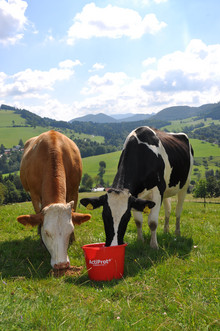Complete raw material utilisation
In the course of this group-wide "Principle of Complete Utilization", AGRANA works hard to convert all valuable parts of the raw materials used – carbohydrates, protein, lipids, fibre and minerals – into marketable, desirable products, thus adding maximum value. The more effectively this is done, the less residual material and waste is left to dispose of and the greater the commercial success. This almost complete utilization of agricultural input materials, combined with a high quality standard, forms the basis for a low waste volume in the group.
Production of feedstuffs and fertilisers closes the ecological loop
In parallel with the well-known, high-quality foods and intermediate products for the downstream processing industry, AGRANA pursues the most sustainable, complete possible utilisation of all its agricultural raw materials by manufacturing a very extensive range of valuable by-products, especially in the Sugar and Starch segments. For each tonne of sugar, approximately one tonne of by-products is also generated, and the Starch segment produces about 0.6 tonnes of co-products per tonne of starch.
The sugar and starch plants offer the by-products carbonated lime and potato fruit water as fertilizers and soil conditioners. Sugar beet pulp, potato protein and (Distillers Dried Grains with Solubles), which is sold under the name ActiProt, are distributed as high quality feed ingredients. In the fruit sector, pomace is sold to the pectin industry or as a feed ingredient.
These by-products make a substantial contribution to the Group's profitability while also fulfilling an ecological function. Widely used as feed and fertiliser, they ensure that important minerals and other nutrients return to the natural environment, thus establishing a desirable closed loop.
Waste: High utilisation rate minimises waste
How AGRANA manages waste: The almost complete utilisation of agricultural inputs (made possible partly by starting with carefully selected raw materials of excellent quality) is the basis for the Group's low volume of waste.
Waste & Disposal Methods (see organisational reporting boundaries)
Fruit segment |
Starch segment |
Sugar segment |
|
| Financial year | 23|24 | 23|24 | 23|24 |
| Waste disposal, in tonnes | 41,721 t | 29,898 t | 13,371 t |
| of which hazardous waste, in tonnes | 338 t | 158 t | 121 t |
| kg waste per tonne of product | 47.0 kg | 20.7 kg | 5.4 kg |
| g azardous waste per tonne of product | 381 g | 109 g | 49 g |
(Source: Reports by waste management contractors; AGRANA calculations)
“Input-output analysis” for AGRANA's corn starch plant in Aschach
This principle can be illustrated by an annual “input-output analysis” for AGRANA's corn starch plant in Aschach, Austria. The values below are based on dry weight.
At the Aschach starch factory, 356,000 tonnes of guaranteed non-GMO corn of many varieties and about 3,000 tonnes of consumables were turned into 228,000 tonnes of marketable starch and saccharification products, 82,000 tonnes of feedstuffs and fertilisers, 24,000 tonnes of corn germ for the production of corn oil, and 18,000 tonnes of intermediate products for further processing in the potato starch plant in Gmünd, Austria. In addition, 2,000 tonnes of corn cobs, corn dust and other organic residuals were used as sources of energy in the nearby biogas facilities. Overall, 359,000 tonnes of input materials were thus converted into 354,000 tonnes of valuable products, amounting to 98.6% utilisation of the input factors.
One raw material = four products
At the Pischelsdorf site, the close integration of the wheat starch plant and the bioethanol factory enable the cereals processed to be utilised to an extent of 100%. Those raw material fractions not utilised in the production of wheat starch and of gluten are used to produce bioethanol and ActiProt®, the premium GMO-free protein feed. Including the high-purity biogenic carbon dioxide which industrial gas group Air Liquide harvests from the fermentation tanks of the bioethanol plant, the Pischelsdorf complex thus manufactures four high-quality products from a single raw material.
